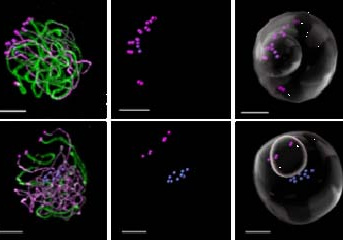Identification of the protein complex responsible for the attachment of chromosomes to the meiocyte nuclear envelope
How parental chromosomes recognize each other amidst a crowded nuclear space filled with non-homologous chromosomes, and manage to associate without causing problematic entanglements, remains a mystery. Thanks to the study of chromosome dynamics in living cells, we now know that during this search and pairing phase, chromosomes exhibit extremely rapid movements—almost as if they were being violently shaken within the nuclear space—and that this dynamic behavior depends on the physical connection of chromosomes to the cytoskeleton through the nuclear envelope.
The findings presented here report the identification, in the model plant Arabidopsis thaliana, of the protein complex required for anchoring chromosomes to the nuclear envelope. This complex is composed of several nuclear envelope proteins (constitutive SUN-domain proteins and a meiosis-specific KASH-domain protein), as well as a meiotic kinesin likely to establish a link with microtubules.
Eliminating these proteins leads to defects in chromosome attachment to the nuclear envelope, a complete absence of chromosome movement, defective bivalent formation, and marked plant sterility. These defects are associated with severe alterations in meiotic recombination, characterized by an abnormal distribution of recombination events across the genome.
These results provide the first insights into the mechanism driving chromosome dynamics during meiotic prophase in plants. They pave the way for new studies aimed at elucidating the precise molecular regulation of this process and determining the extent to which these mechanisms are conserved across species.
Furthermore, this work highlights the key role of chromosome motion in plant reproduction in general, and in the distribution of recombination events in particular. It underscores the fundamental importance of chromosome dynamics in the control of meiosis and opens new perspectives for understanding the cellular mechanisms regulating genome stability and genetic diversity.
Research developed at the Institute Jean-Pierre Bourgin for Plant Sciences in collaboration.
Back

Légend: Defective attachment of telomeres in mutants of the meiotic LINC complex. Telomeres are shown as pink spheres (when located at the nuclear envelope) or blue spheres (when found in the nucleoplasm). Left panel: Meiocytes of A. thaliana after immunodetection of chromosome axes (in green and purple). Central panel: Position of the telomeres. Right panel: Telomeres, nuclear envelope (large transparent sphere), and nucleolus (small sphere).
IJPB Highlight
Référence:
Bowei C, Tiscareno-Andrade M, Yanru Luo Y, Sandrine Lefranc S, Fei CaoF, Chambon A, Yuan X, Peuch M, Zhang Y, Hurel A, Guérin J, Vrielynck N, Mézard C, Andrey P, Cromer L , Yang C, Grelon M. Identification of the cytoplasmic motor-LINC complex module involved in meiotic 2 prophase rapid chromosome movements in Arabidopsis thaliana. Nature Plants July 2025
Contact: Mathilde Grelon,contact
IJPB teams:
> "Meiosis Mechanisms" MeioMe team
> "Modeling and Digital Imaging" MiN team
Platforms of the The "Plant Observatory":
> "The Plant Observatory - Plant Facilities" PO-Plants
> "The Plant Observatory - Cytology/Imaging" PO-Cyto